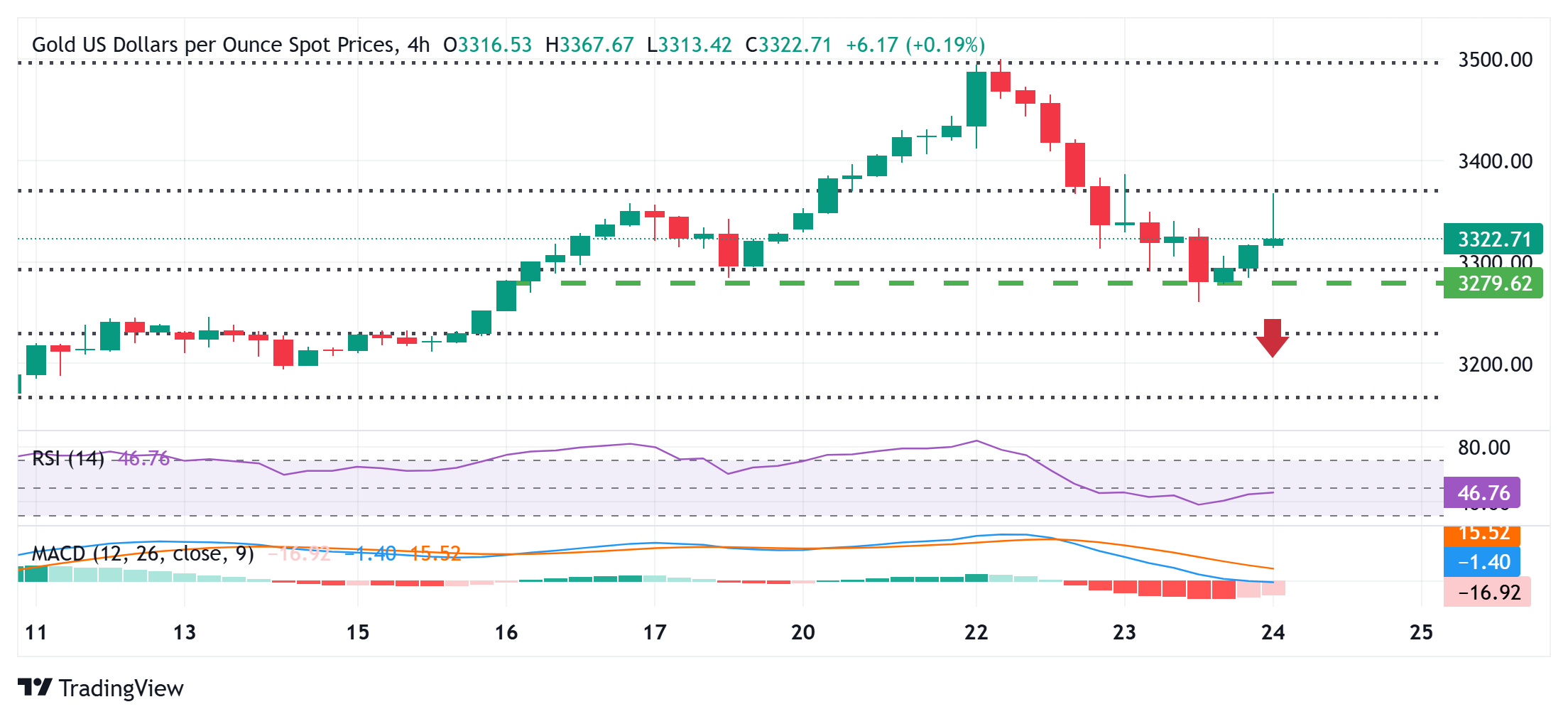- Gold price regains positive traction as fading US-China trade optimism revives safe-haven demand.
- The US economic worries and Fed rate cut bets undermine the USD, also benefiting the commodity.
- A positive risk tone holds back the XAU/USD bulls from placing aggressive bets and caps the upside.
Gold price (XAU/USD) retreats around $50 from the daily swing high and trades just below the $3,320 level heading into the European session, still up for the first time in three days. US Treasury Secretary Scott Bessent tempered expectations for a quick resolution to the US-China trade standoff, which, in turn, helps revive demand for the safe-haven bullion.
Apart from this, the growing acceptance that the Federal Reserve (Fed) will resume its rate-cutting cycle soon and the emergence of some US Dollar (USD) selling turns out to be other factors lending support to the non-yielding Gold price. That said, hopes for a possible US-China trade deal, easing fears about the Fed independence and a positive risk tone cap the XAU/USD pair.
Daily Digest Market Movers: Gold price bulls remain on the sidelines amid improving risk sentiment
- US Treasury Secretary Scott Bessent denied reports that the White House is considering unilaterally slashing tariffs on Chinese imports. Bessent added that high duties imposed by both sides need to come down mutually before talks can begin, tempering hopes for a quick resolution to the US-China trade standoff and reviving demand for the traditional safe-haven Gold price.
- The Federal Reserve’s Beige Book showed that pervasive uncertainty over US President Donald Trump’s shifting tariff plans threatens to curtail growth in the months ahead. The report further revealed that consumer spending remains mixed, while the labor market has shown signs of cooling after stalling or edging lower in many Fed districts, pointing to a gloomy outlook.
- On the economic data front, a preliminary reading of S&P Global’s Composite PMI indicated US business activity expanded at a slower pace in April. The data revealed a diverging performance across sectors, with manufacturing activity continuing to grow modestly, while the non-manufacturing PMI pointed to signs that demand in the services sector may be losing steam.
- The US Dollar erodes a part of its recovery gains registered over the past two days amid bets that the Federal Reserve will resume its rate-cutting cycle in June and lower borrowing costs at least three times by the end of this year. This turns out to be another factor that benefits the non-yielding yellow metal, though a generally positive risk tone might cap any further gains.
- Meanwhile, signs of easing trade tensions between the world’s two largest economies and receding fears that the Fed could lose its autonomy boosted investors’ appetite for riskier assets. This might hold back bulls from placing fresh bets around the XAU/USD as traders now look to the US macro data – Jobless Claims and Durable Goods Orders – for short-term impetuses.
Gold price might continue to show some resilience below the $3,300 mark and the 38.2% Fibo. level

From a technical perspective, the precious metal showed some resilience below the 38.2% Fibonacci retracement level of the latest leg up from the vicinity of mid-$2,900s or the monthly swing low. The subsequent move up, however, falters near the 23.6% Fibo. level, around the $3,367-3,368 region, which should now act as a key pivotal point. Given that oscillators on the daily chart are still holding comfortably in positive territory, some follow-through buying should allow the Gold price to reclaim the $3,400 mark. The momentum could extend further towards the $3,425-3,427 intermediate hurdle, above which bulls could make a fresh attempt to conquer the $3,500 psychological mark.
On the flip side, the $3,300 mark, followed by the $3,288 zone (38.2% Fibo. level) and the overnight swing low, around the $3,260 area, could offer support to the XAU/USD. A convincing break below the latter could drag the Gold price further toward the 50% retracement level, around the $3,225 region. Some follow-through selling, leading to a subsequent slide below the $3,200 mark, will suggest that the precious metal has topped out in the near term and pave the way for an extension of this week’s retracement slide from the all-time peak.
Fed FAQs
Monetary policy in the US is shaped by the Federal Reserve (Fed). The Fed has two mandates: to achieve price stability and foster full employment. Its primary tool to achieve these goals is by adjusting interest rates.
When prices are rising too quickly and inflation is above the Fed’s 2% target, it raises interest rates, increasing borrowing costs throughout the economy. This results in a stronger US Dollar (USD) as it makes the US a more attractive place for international investors to park their money.
When inflation falls below 2% or the Unemployment Rate is too high, the Fed may lower interest rates to encourage borrowing, which weighs on the Greenback.
The Federal Reserve (Fed) holds eight policy meetings a year, where the Federal Open Market Committee (FOMC) assesses economic conditions and makes monetary policy decisions.
The FOMC is attended by twelve Fed officials – the seven members of the Board of Governors, the president of the Federal Reserve Bank of New York, and four of the remaining eleven regional Reserve Bank presidents, who serve one-year terms on a rotating basis.
In extreme situations, the Federal Reserve may resort to a policy named Quantitative Easing (QE). QE is the process by which the Fed substantially increases the flow of credit in a stuck financial system.
It is a non-standard policy measure used during crises or when inflation is extremely low. It was the Fed’s weapon of choice during the Great Financial Crisis in 2008. It involves the Fed printing more Dollars and using them to buy high grade bonds from financial institutions. QE usually weakens the US Dollar.
Quantitative tightening (QT) is the reverse process of QE, whereby the Federal Reserve stops buying bonds from financial institutions and does not reinvest the principal from the bonds it holds maturing, to purchase new bonds. It is usually positive for the value of the US Dollar.







